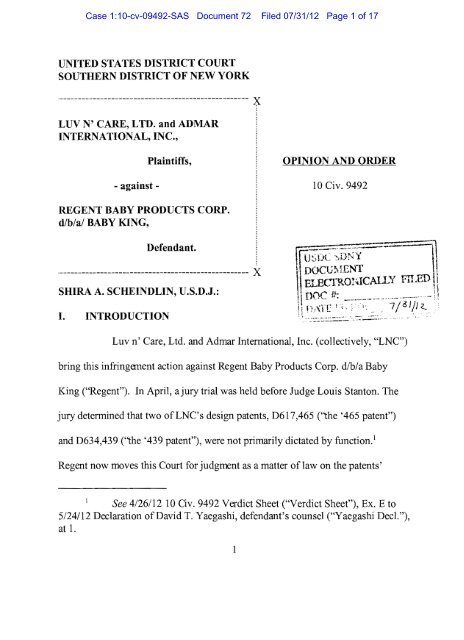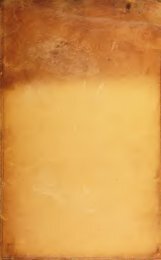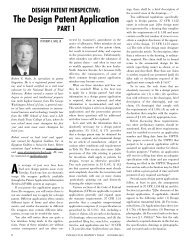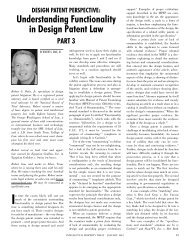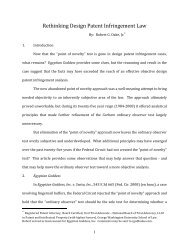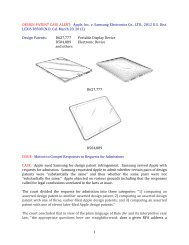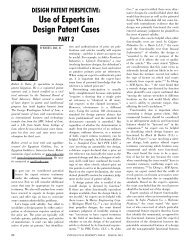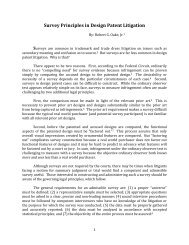Luv N' Care, Ltd. v. Regent Baby Prods. Corp. - Design Patent School
Luv N' Care, Ltd. v. Regent Baby Prods. Corp. - Design Patent School
Luv N' Care, Ltd. v. Regent Baby Prods. Corp. - Design Patent School
You also want an ePaper? Increase the reach of your titles
YUMPU automatically turns print PDFs into web optimized ePapers that Google loves.
Case 1:10-cv-09492-SAS Document 72 Filed 07/31/12 Page 1 of 17<br />
UNITED STATES DISTRICT COURT<br />
SOUTHERN DISTRICT OF NEW YORK<br />
._-------------------------------------------------- ~<br />
LUV <strong>N'</strong> CARE, LTD. and ADMAR<br />
INTERNATIONAL, INC.,<br />
Plaintiffs,<br />
OPINION AND ORDER<br />
- against- 10 Civ. 9492<br />
REGENT BABY PRODUCTS CORP.<br />
d/b/a/ BABY KING,<br />
Defendant .<br />
._-------------------------------------------------- )(<br />
SHIRA A. SCHEINDLIN, U.S.D.J.:<br />
I. INTRODUCTION<br />
<strong>Luv</strong> n' <strong>Care</strong>, <strong>Ltd</strong>. and Admar International, Inc. (collectively, "LNC")<br />
bring this infringcrnent action against <strong>Regent</strong> <strong>Baby</strong> Products <strong>Corp</strong>. d/b/a <strong>Baby</strong><br />
King ("<strong>Regent</strong>"). In April, ajury trial was held before Judge Louis Stanton. The<br />
jury determined that two ofLNC's design patents, D617,465 (''the '465 patent")<br />
and D634,439 (''the '439 patent"), were not primarily dictated by function. I<br />
<strong>Regent</strong> now moves this Court for judgment as a matter oflaw on the patents'<br />
See 4/26112 10 Qv. 9492 Verdict Sheet ("Verdict Sheet"), Ex. E to<br />
5/24112 Declaration ofDavid T. Yaegashi, defendant's counsel ("Yaegashi Decl."),<br />
at 1.<br />
1
Case 1:10-cv-09492-SAS Document 72 Filed 07/31/12 Page 2 of 17<br />
functionality, or in the alternative, a new trial. For the reasons set forth below,<br />
<strong>Regent</strong>’s motion is denied.<br />
II.<br />
BACKGROUND<br />
LNC designs and sells baby products internationally. 2<br />
<strong>Regent</strong> is a<br />
nationwide distributor of baby products. 3<br />
This action concerns two of LNC’s<br />
design patents, the ‘465 and ‘439 patents. 4<br />
The ‘465 patent discloses the entirety<br />
of a child’s drinking cup 5 and includes five drawing sheets. 6<br />
The ‘439 patent<br />
discloses a cup top 7 and includes six drawing sheets. 8<br />
The two patents are in the<br />
same patent family. 9<br />
<strong>Regent</strong> argues that the ‘465 and ‘439 patents are invalid<br />
because they are purely functional. 10<br />
2<br />
3<br />
See Complaint 8.<br />
See id. 7.<br />
4<br />
See Plaintiffs’ Memorandum of Law in Opposition to Motion for<br />
Judgment as a Matter of Law or a New Trial (“Pl. Mem.”), at 4 n.1.<br />
5<br />
Decl., at 2.<br />
6<br />
7<br />
8<br />
9<br />
See 7/29/11 Letter from <strong>Regent</strong> to Judge Stanton, Ex. A to Yaegashi<br />
See id. at 4.<br />
See id. at 2.<br />
See id. at 4.<br />
See id. at 2.<br />
10<br />
See Defendant’s Memorandum of Law in Support of Judgment as a<br />
Matter of Law or a New Trial (“Def. Mem.”), at 1.<br />
2
Case 1:10-cv-09492-SAS Document 72 Filed 07/31/12 Page 3 of 17<br />
The verdict form presented the jury with one question for each design<br />
patent — is the appearance of the design claimed in the patent “primarily dictated<br />
by its function?” 11 <strong>Regent</strong> argues that this question involved claim construction —<br />
a matter for the court, not the jury — and requests that I engage in claim<br />
construction at this time. 12<br />
<strong>Regent</strong> further argues that the verdict was not supported<br />
by the evidence and that <strong>Regent</strong> was unfairly prejudiced by LNC’s comments<br />
during the trial. 13<br />
LNC argues that the jury verdict was supported by sufficient<br />
evidence, 14 and that <strong>Regent</strong> waived its argument that the jury was impermissibly<br />
tasked with claim construction by failing to either object to the jury instructions or<br />
preserve the issue in its Rule 50(a) motion. 15<br />
IV.<br />
LEGAL STANDARD<br />
A. Motion for Judgment as a Matter of Law Under Rule 50 and<br />
Motion for a New Trial Under Rule 59<br />
A court may render judgment as a matter of law when “a party has<br />
been fully heard on an issue during a jury trial and the court finds that a reasonable<br />
11<br />
12<br />
13<br />
14<br />
15<br />
Verdict Sheet, at 1.<br />
See Def. Mem. at 1–2.<br />
See id. at 2, 20.<br />
See Pl. Mem. at 9–19.<br />
See id. at 4–6.<br />
3
Case 1:10-cv-09492-SAS Document 72 Filed 07/31/12 Page 4 of 17<br />
jury would not have a legally sufficient evidentiary basis to find for the party on<br />
that issue.” 16<br />
The standard for granting judgment as a matter of law “mirrors” the<br />
standard for granting summary judgment. 17<br />
Accordingly, in ruling on such a<br />
motion, the trial court is required to<br />
consider the evidence in the light most favorable to the party<br />
against whom the motion was made and to give that party the<br />
benefit of all reasonable inferences that the jury might have drawn<br />
in his favor from the evidence. The court cannot assess the weight<br />
of conflicting evidence, pass on the credibility of the witnesses, or<br />
substitute its judgment for that of the jury. 18<br />
A jury verdict should not be set aside lightly. A court may not grant judgment as a<br />
matter of law unless: (1) there is such a “‘complete absence of evidence<br />
supporting the verdict that the jury’s findings could only have been the result of<br />
sheer surmise and conjecture’” or (2) there is “‘such an overwhelming amount of<br />
evidence in favor of the movant that reasonable and fair minded [persons] could<br />
16<br />
Fed. R. Civ. P. 50(a)(1).<br />
17<br />
See Reeves v. Sanderson Plumbing <strong>Prods</strong>., Inc., 530 U.S. 133, 150<br />
(2000) (quotation marks and citations omitted); Zellner v. Summerlin, 494 F.3d<br />
344, 371 (2d Cir. 2007).<br />
18<br />
Tolbert v. Queens Coll., 242 F.3d 58, 70 (2d Cir. 2001) (quotation<br />
marks and citation omitted). Accord Caceres v. Port Authority of N.Y. and N.J.,<br />
631 F.3d 620, 622 (2d Cir. 2011).<br />
4
Case 1:10-cv-09492-SAS Document 72 Filed 07/31/12 Page 5 of 17<br />
not arrive at a verdict against [it].’” 19<br />
A “court may, on motion, grant a new trial on all or some of the issues<br />
. . . after a jury trial, for any reason for which a new trial has heretofore been<br />
granted in an action at law in federal court.” 20<br />
The legal test for granting a new<br />
trial is less stringent than for granting judgment as a matter of law. “Unlike a<br />
motion for judgment as a matter of law, a motion for a new trial may be granted<br />
even if there is substantial evidence to support the jury’s verdict.” 21<br />
Nevertheless,<br />
in practice, courts do not grant new trials as freely as the language suggests. “‘A<br />
motion for a new trial ordinarily should not be granted unless the trial court is<br />
convinced that the jury has reached a seriously erroneous result or that the verdict<br />
is a miscarriage of justice.’” 22<br />
Under Federal Rule of Civil Procedure 50(b),<br />
[n]o later than 28 days after the entry of judgment . . . the movant<br />
may file a renewed judgment as a matter of law and may include<br />
19<br />
Altria Grp., Inc. v. U.S., 658 F.3d 276, 290 (2d Cir. 2011) (quoting<br />
Kosmynka v. Polaris Indus., Inc., 462 F.3d 74, 79 (2d Cir. 2006)).<br />
20<br />
Fed. R. Civ. P. 59(a)(1)(A).<br />
21<br />
Caruolo v. John Crane, Inc., 226 F.3d 46, 54 (2d Cir. 2000)<br />
(quotation marks and citation omitted).<br />
22<br />
Townsend v. Benjamin Enters., Inc., 679 F.3d 41, 51 (2d Cir. 2012)<br />
(quoting Medforms, Inc. v. Healthcare Mgmt. Solutions, Inc., 290 F.3d 98, 106 (2d<br />
Cir. 2002)).<br />
5
Case 1:10-cv-09492-SAS Document 72 Filed 07/31/12 Page 6 of 17<br />
an alternative or joint request for a new trial under Rule 59 . . . [—<br />
i]n ruling on the renewed motion, the court may: (1) allow<br />
judgment on the verdict, if the jury returned a verdict; (2) order a<br />
new trial; or (3) direct entry of judgment as a matter of law.<br />
V. APPLICABLE LAW<br />
A. Functionality<br />
“‘A design patent protects the non-functional aspects of an ornamental<br />
design as seen as a whole and as shown in the patent.’” 23<br />
“An aspect is functional<br />
‘if it is essential to the use or purpose of the article or if it affects the cost or quality<br />
of the article.’” 24<br />
“The design of a useful article is deemed to be functional when<br />
‘the appearance of the claimed design is ‘dictated by’ the use or purpose of the<br />
article.’” 25<br />
“Whether a patented design is functional or ornamental is a question of<br />
fact.” 26<br />
The Federal Circuit has held that “‘[w]here a design contains both<br />
functional and non-functional elements, the scope of the claim must be construed<br />
23<br />
Amini Innovation <strong>Corp</strong>. v. Anthony Cal., Inc., 439 F.3d 1365, 1370<br />
(Fed. Cir. 2006) (quoting KeyStone Retaining Wall Sys., Inc. v. Westrock, Inc., 997<br />
F.2d 1444, 1450 (Fed. Cir. 1993)).<br />
24<br />
Id. at 1371 (quoting Inwood Labs., Inc. v. Ives Labs., Inc., 456 U.S.<br />
844, 851 (1982)).<br />
25<br />
PHG Techs., LLC v. St. John Cos., 469 F.3d 1361, 1366 (Fed. Cir.<br />
2006) (quoting L.A. Gear, Inc. v. Thom McAn Shoe Co., 988 F.2d 1117, 1123 (Fed.<br />
Cir. 1993)).<br />
26<br />
Id. at 1365.<br />
6
Case 1:10-cv-09492-SAS Document 72 Filed 07/31/12 Page 7 of 17<br />
in order to identify the non-functional aspects of the design as shown in the<br />
patent.’” 27<br />
“[T]he preferable course ordinarily will be for a district court not to<br />
attempt to construe a design patent claim”; however, “the distinction between the<br />
functional and ornamental aspects of a design” is an issue on which “a court’s<br />
guidance would be useful to the fact finder.” 28<br />
“In determining whether a design is primarily functional or primarily<br />
ornamental the claimed design is viewed in its entirety, for the ultimate question is<br />
not the functional or decorative aspect of each separate feature, but the overall<br />
appearance of the article, in determining whether the claimed design is dictated by<br />
the utilitarian purpose of the article.” 29<br />
“If the patented design is primarily<br />
functional rather than ornamental, the patent is invalid.” 30<br />
“‘The elements of the<br />
design may indeed serve a utilitarian purpose, but it is the ornamental aspect that is<br />
the basis of the design patent.’” 31<br />
27<br />
Richardson v. Stanley Works, Inc., 597 F.3d 1288, 1293 (Fed. Cir.<br />
2010) (quoting OddzOn <strong>Prods</strong>., Inc. v. Just Toys, Inc., 122 F.3d 1396, 1405 (Fed.<br />
Cir. 1997)).<br />
28<br />
Id. (citing Egyptian Goddess, Inc. v. Swisa, Inc., 543 F.3d 665,<br />
679–80 (Fed. Cir. 2008)).<br />
29<br />
L.A. Gear, 988 F.2d at 1123 (citing Lee v. Dayton-Hudson <strong>Corp</strong>., 838<br />
F.2d 1186, 1189 (Fed. Cir. 1988)).<br />
30<br />
31<br />
Richardson, 597 F.3d at 1293–94 (citing Lee, 838 F.2d at 1188).<br />
Id. at 1294 (quoting L.A. Gear, 988 F.2d at 1123).<br />
7
Case 1:10-cv-09492-SAS Document 72 Filed 07/31/12 Page 8 of 17<br />
court may consider<br />
When determining functionality in the context of a design patent, the<br />
“whether the protected design represents the best design; whether<br />
alternative designs would adversely affect the utility of the<br />
specified article; whether there are any concomitant utility patents;<br />
whether the advertising touts particular features of the design as<br />
having specific utility; and whether there are any elements in the<br />
design or an overall appearance clearly not dictated by function.” 32<br />
VI.<br />
DISCUSSION<br />
A. The Jury Verdict Was Not Clearly Erroneous and Was Supported<br />
by Sufficient Evidence<br />
I will not address <strong>Regent</strong>’s claim construction arguments because they<br />
are premature. Claim construction can occur at any point before an infringement<br />
determination, and it may take into account a jury’s findings of fact. 33<br />
The jury did<br />
32<br />
PHG Techs., 469 F.3d at 1366 (quoting Berry Sterling <strong>Corp</strong>. v. Pescor<br />
Plastics, Inc., 122 F.3d 1452, 1456 (Fed. Cir. 1997)).<br />
33<br />
See Depaoli v. Daisy Mfg. Co., No. 07ocv–11778–DPW, 2009 WL<br />
2145721, at *5 (D. Mass. July 14, 2009) (“To the extent the scope of the claim<br />
must be limited by prosecution history or functionality, I will address those issues<br />
definitively if and when they are raised at some later stage in these proceedings,<br />
such as resolution of motions for summary judgment or as part of the jury<br />
instructions at trial.”). See also Colgate-Palmolive Co. v. Ranir, L.L.C., No.<br />
06–417, 2007 WL 2225888, at *3 (D. Del. July 31, 2007) (“Cognizant of the<br />
court’s role as the construer of patent claims and the need for claim construction to<br />
be complete before a jury deliberates on infringement, the court may further limit<br />
the current construction at trial by factual determinations regarding functionality<br />
and ornamentality of the included features.”); ADC Telecomm., Inc. v. Panduit<br />
<strong>Corp</strong>., 200 F. Supp. 2d 1022, 1033 (D. Minn. 2002) (finding that because fact<br />
issues permeated the parties’ arguments concerning functionality, functionality was<br />
8
Case 1:10-cv-09492-SAS Document 72 Filed 07/31/12 Page 9 of 17<br />
not construe the claim, nor does its finding preclude claim construction at a later<br />
date. 34<br />
Thus, there is one issue before the Court: whether the jury verdict on<br />
functionality was clearly erroneous because it was not sufficiently supported by the<br />
evidence.<br />
The parties presented the following evidence regarding functionality<br />
at trial.<br />
1. The ‘225 Utility <strong>Patent</strong><br />
<strong>Regent</strong> proffered LNC’s 6,994,225 (“the ‘225 patent”) as a utility<br />
patent that discloses the utilitarian advantages of the design. 35<br />
Indeed this factor<br />
weighs against LNC, as the ‘225 patent describes the functionality of individual<br />
elements. However, the functionality inquiry asks whether the overall design is<br />
best left to the fact-finder).<br />
34<br />
Judge Stanton concluded that, while a jury may not construe the<br />
claims, it may make an overall determination of invalidity due to functionality.<br />
See Def. Mem. at 4. See <strong>Luv</strong> N’ <strong>Care</strong>, <strong>Ltd</strong>. v. Walgreen Co., 695 F. Supp. 2d 125,<br />
135 (S.D.N.Y. 2010) (discussing the potential for a jury trial on the issue of<br />
functionality); Dexas Int’l, <strong>Ltd</strong>. v. Office Max Inc., No. 6:07cv396, 2009 WL<br />
252164, at *7 n.4 (E.D. Tex. Jan. 30, 2009) (adopting a brief verbal claim<br />
construction to “appropriately guide the jury[’s]” infringement determination, yet<br />
“express[ing] no opinion as to whether the patented design incorporates functional<br />
elements”).<br />
35<br />
See Def. Mem. at 10.<br />
9
Case 1:10-cv-09492-SAS Document 72 Filed 07/31/12 Page 10 of 17<br />
dictated by utility. 36<br />
2. Advertising<br />
<strong>Regent</strong> offered various examples of LNC advertising that touts the<br />
functional qualities of individual elements of LNC cups. 37<br />
These advertisements<br />
highlight individual attributes such as the silicone spout — for example, one<br />
advertisement states that the spout is “designed to prevent drips and spills.” 38<br />
Yet,<br />
these advertisements do not demonstrate that the overall design is dictated by<br />
function. Even where individual elements are dictated by function, the overall<br />
design may still be ornamental. 39<br />
36<br />
See L.A. Gear, 988 F.2d at 1123 (“[T]he utility of each of the various<br />
elements that comprise the design is not the relevant inquiry with respect to a<br />
design patent. In determining whether a design is primarily functional or primarily<br />
ornamental the claimed design is viewed in its entirety, for the ultimate question is<br />
not the functional or decorative aspect of each separate feature, but the overall<br />
appearance of the article, in determining whether the claimed design is dictated by<br />
the utilitarian purpose of the article.”) (citing Lee, 838 F.2d at 1189).<br />
37<br />
See LNC bottle advertisements (“LNC ads”), Exs. I, J, K, L to<br />
Yaegashi Decl.<br />
38<br />
See LNC ads, Ex. J to Yaegashi Decl., at 1.<br />
39<br />
See Power Controls <strong>Corp</strong>. v. Hybrinetics, Inc., 806 F.2d 234, 240<br />
(Fed. Cir. 1986) (“In determining whether a design is primarily functional, the<br />
purposes of the particular elements of the design necessarily must be considered.”).<br />
However, ‘“[T]he determination of whether the patented design is dictated by the<br />
function of the article of manufacture must ultimately rest on an analysis of its<br />
overall appearance.” PHG Techs., 469 F.3d at 1366 (quoting Berry Sterling, 122<br />
F.3d at 1455). <strong>Regent</strong> also cites case law holding that the functionality inquiry<br />
10
Case 1:10-cv-09492-SAS Document 72 Filed 07/31/12 Page 11 of 17<br />
3. Alternative <strong>Design</strong>s<br />
LNC put forth many examples of alternative designs that were<br />
available to <strong>Regent</strong>. 40<br />
<strong>Regent</strong> argues that LNC’s alternative designs were legally<br />
insufficient because they could not be manufactured without additional cost or loss<br />
of quality. 41<br />
LNC correctly argues that their alternatives — differently-shaped<br />
cups that performed the same function as effectively as the LNC design — were<br />
appropriate. 42<br />
The jury was entitled to weigh the alternative designs more heavily<br />
concerns the overall design — not the individual elements. See Rip-It Holdings,<br />
LLC v. Wilson Hunt Int’l, <strong>Ltd</strong>., No. 6:11–cv–1733–Orl–28GJK, 2012 WL 113529,<br />
at *4 (M.D. Fla. Jan. 13, 2012) (“The mere fact that each element of a design<br />
serves some functional purpose does not necessarily mean that the overall design is<br />
dictated by function.”) (citing L.A. Gear, 988 F.2d at 1123). “[B]ut when the<br />
function of each element cannot be separated from the overall design, it indicates<br />
that the entire design is dictated by function.” Id. (citing PHG Techs., 469 F.3d at<br />
1368).<br />
40<br />
See Pl. Mem. at 12.<br />
41<br />
See Def. Mem. at 15. PHG Techs., 469 F.3d at 1367 (finding that a<br />
“full inquiry with respect to alleged alternative designs includes a determination as<br />
to whether the alleged ‘alternative designs would adversely affect the utility of the<br />
specified article’” — not the cost or quality of the article) (quoting Rosco, Inc. v.<br />
Mirror Lite Co., 304 F.3d 1373, 1378 (Fed. Cir. 2002)). Cf. Valu Eng’g, Inc. v.<br />
Rexnord <strong>Corp</strong>., 278 F.3d 1268, 1276 n.5 (Fed. Cir. 2002) (finding, in the<br />
trademark context, that a feature may be functional if it affects the cost or quality<br />
of the article).<br />
42<br />
See Plaintiffs’ Alternative <strong>Design</strong>s, Ex. 4 to 6/11/12 Declaration of<br />
Benjamin H. Graf, plaintiffs’ counsel (“Graf. Decl.”), at 1–15. See also Rosco, 304<br />
F.3d at 1378 (“‘[T]he design must not be governed solely by function, i.e., . . . this<br />
is not the only possible form of the article that could perform its function.’”)<br />
11
Case 1:10-cv-09492-SAS Document 72 Filed 07/31/12 Page 12 of 17<br />
than the other facts, 43 and credit the alternative design testimony of Nouri E.<br />
Hakim, the inventor of the LNC designs — testimony which was corroborated by<br />
<strong>Regent</strong>’s witness, Jim Holley, to the extent that Holley testified that one of the cups<br />
was an alternative design. 44<br />
4. Best <strong>Design</strong><br />
<strong>Regent</strong> restates its utility patent evidence to satisfy this factor. 45<br />
Plaintiffs’ expert, Cooper Woodring testified that the embodiments of the patentsin-suit<br />
were constantly being improved. 46<br />
Hakim testified that a later design<br />
(quoting Seiko Epson <strong>Corp</strong>. v. Nu–Kote Int’l, Inc., 190 F.3d 1360, 1368 (Fed. Cir.<br />
1999)). “‘When there are several ways to achieve the function of an article of<br />
manufacture, the design of the article is more likely to serve a primarily ornamental<br />
purpose.’” Id. (quoting L.A. Gear, 988 F.2d at 1123).<br />
43<br />
See PHG Techs., 469 F.3d at 1367 (“‘[T]he presence of alternative<br />
designs may or may not assist in determining whether the challenged design can<br />
overcome a functionality challenge. Consideration of alternative designs, if<br />
present, is a useful tool that may allow a court to conclude that a challenged design<br />
is not invalid for functionality.’”) (quoting Berry Sterling, 122 F.3d at 1455).<br />
44<br />
See Holley Cross, Ex. 14 to Graf. Decl., at 420. See also R.F.M.A.S.,<br />
Inc. v. Mimi So, 619 F. Supp. 2d 39, 81 n.21 (S.D.N.Y. 2009) (“‘[F]unctionality is<br />
a question of fact. The record contains competing expert opinions on the issue of<br />
functionality, either of which the jury could credit.’”) (quoting Keystone Mfg. Co.,<br />
Inc. v. Jaccard <strong>Corp</strong>., 394 F. Supp. 2d 543, 562 (W.D.N.Y. 2005)).<br />
45<br />
46<br />
See Def. Mem. at 16.<br />
See Cooper Direct, Ex. 11 to Graf. Decl., at 270.<br />
12
Case 1:10-cv-09492-SAS Document 72 Filed 07/31/12 Page 13 of 17<br />
embodiment was manufactured more cheaply, with no loss of function. 47<br />
5. Individual Elements or Overall <strong>Design</strong> Not Dictated by<br />
Functionality<br />
Hakim testified that he designed the cup to be attractive. 48<br />
Most<br />
significantly, he also testified that he had designed the cup prior to designing the<br />
valve that went inside it. 49<br />
<strong>Regent</strong> rebuts this evidence by arguing that the time gap<br />
between the filing of the ‘225 patent and the design patents indicates that the ‘225<br />
patent dictated the design. 50<br />
Given the evidence that was offered by LNC to demonstrate that its<br />
design patent was not primarily dictated by function, I cannot conclude that there<br />
was either insufficient evidence to support the verdict or overwhelming evidence in<br />
favor of <strong>Regent</strong>. Thus, I cannot conclude that the verdict was clearly erroneous. 51<br />
47<br />
48<br />
49<br />
50<br />
See Hakim Direct, Ex. 14 to Graf. Decl., at 435.<br />
See Hakim Redirect, Ex. 10 to Graf. Decl., at 240.<br />
See Hakim Direct, Ex. 8 to Graf Decl., at 57.<br />
See Def. Mem. at 18.<br />
51<br />
Johnson & Johnson Vision <strong>Care</strong>, Inc. v. CIBA Vision <strong>Corp</strong>., 634 F.<br />
Supp. 2d 1293, 1304 (M.D. Fla. 2008) (“Because of the presumption of validity, a<br />
patentee responding to a challenge to the patent’s validity need only submit<br />
sufficient evidence to rebut any proof of invalidity offered by the challenger, and,<br />
where the challenger fails to identify any persuasive evidence of invalidity, the<br />
very existence of the patent satisfies the patentee’s burden on the validity issue.”)<br />
(citing Canon Computer Sys., Inc. v. Nu-Kote Int’l, Inc., 134 F.3d 1085, 1088 (Fed.<br />
Cir. 1998)). The patents-in-suit were recently reexamined by the <strong>Patent</strong> Office,<br />
13
Case 1:10-cv-09492-SAS Document 72 Filed 07/31/12 Page 14 of 17<br />
B. Prejudice Does Not Warrant Judgement as a Matter of Law or a<br />
New Trial<br />
<strong>Regent</strong> argues that it was prejudiced by LNC’s statements of the law<br />
and LNC’s false accusation of discovery violations. LNC argues that because<br />
<strong>Regent</strong> did not object to LNC’s statements, they have waived their right to<br />
challenge the verdict on that basis. I find that <strong>Regent</strong> did not waive its<br />
objections, 52 but the cited statements amount — at most — to harmless error. 53<br />
Any potentially harmful effect of statements made by LNC regarding the<br />
which found the functionality arguments of two different defendants, Toys R’ Us<br />
and Munchkin, without merit, although the examiner primarily focused on<br />
obviousness. See 7/25/12 Plaintiffs’ letter to the Court at 2; 7/26/12 Defendant’s<br />
Letter to the Court at 1.<br />
52<br />
See Henry v. Wyeth Pharm., Inc., 616 F.3d 134, 152 (2d Cir. 2010)<br />
(finding that a failure to properly object during trial subjects the trial court’s<br />
actions to a plain error standard).<br />
53<br />
See Marcic v. Reinauer Transp. Cos., 397 F.3d 120, 127 (2d Cir.<br />
2005) (finding that disparaging comments about a party, his witnesses, and the<br />
case did not amount to prejudicial conduct, as “‘[n]ot every improper or poorly<br />
supported remark made in summation irreparably taints the proceedings; only if<br />
counsel’s conduct created undue prejudice or passion which played upon the<br />
sympathy of the jury, should a new trial be granted.’”) (quoting Matthews v. CTI<br />
Container Transp. Int’l, Inc., 871 F.2d 270, 278 (2d Cir. 1989)). See also<br />
Patterson v. Balsamico, 440 F.3d 104, 119 (2d Cir. 2006) (“[B]ecause attorneys<br />
are given ‘wide latitude in formulating their arguments’ to the jury, ‘[r]arely will<br />
an attorney’s conduct so infect a trial with undue prejudice or passion as to require<br />
reversal.’”) (quoting Reilly v. Natwest Mkts. Grp. Inc., 181 F.3d 253, 271 (2d Cir.<br />
1999)).<br />
14
Case 1:10-cv-09492-SAS Document 72 Filed 07/31/12 Page 15 of 17<br />
applicable law was negated by Judge Stanton’s instructions. 54<br />
An accusation of<br />
discovery violations, which indeed may have occurred, 55 is also insufficient to<br />
require a new trial or judgment as a matter of law. 56<br />
V. CONCLUSION<br />
Based on the foregoing, <strong>Regent</strong>’s motion is denied. The Clerk of the<br />
Court is directed to close this motion (Docket No. 65). A conference is scheduled<br />
for August 23, 2012, at 4:30 p.m. in Courtroom 15C.<br />
54<br />
See AIG Global Secs. Lending <strong>Corp</strong>. v. Banc of Am. Secs., LLC,<br />
386 Fed. App’x 5, 8 (2d Cir. 2010) (finding that counsel’s potentially invalid legal<br />
theories did not warrant a new trial for the adversary, particularly when, “in any<br />
event,” the judge instructs the jury on the law). See also Frometa v. Diaz-Diaz,<br />
348 Fed. App’x 621 (2d Cir. 2009) (finding misstatements of the law and improper<br />
comments insufficient to trigger a new trial when there was sufficient evidence to<br />
support the jury’s verdict).<br />
55<br />
LNC provided evidence that <strong>Regent</strong> withheld the physical<br />
embodiment of one of its cited designs. See Pl. Mem. at 24.<br />
56<br />
See Air China, <strong>Ltd</strong>. v. Kopf, Nos. 10–3289–cv(L), 10–3571–cv(XAP),<br />
10–3577–cv(XAP), 10–3730–cv(XAP), 10–4128–cv(XAP), 10–4166–cv(XAP),<br />
10–4226–cv(XAP), 2012 WL 1109372, *4 (2d Cir. Apr. 4, 2012) (“‘[E]xtreme[ly]<br />
inflammatory remarks’ by counsel during the closing to the jury, such as ‘[T]his<br />
man is a disgrace . . . ,’ a ‘schmuck,’ a ‘scam artist’ and ‘con man’ who had a<br />
‘fundamental dishonesty’” did not demand a new trial because they were isolated<br />
comments in an otherwise appropriate closing). See also Marcic, 397 F.3d at 126<br />
(“[A]lmost all of the statements [defendant] relies on were statements suggesting<br />
that [defendant] or his witnesses lied or that their testimony was unbelievable.<br />
Such statements were not statements of the evidence at all, but were rather<br />
argument calling on the jury to draw inferences from the evidence.”).<br />
15
Case 1:10-cv-09492-SAS Document 72 Filed 07/31/12 Page 16 of 17<br />
Dated:<br />
New York, New York<br />
Ju1y31,2012<br />
16
Case 1:10-cv-09492-SAS Document 72 Filed 07/31/12 Page 17 of 17<br />
For Plaintiffs:<br />
Lee A. Goldberg, Esq.<br />
Morris E. Cohen, Esq.<br />
Goldberg Cohen, LLP<br />
1350 Avenue of the Americas, Suite 425<br />
New York, New York 10019<br />
(646) 380-2087<br />
For Defendant:<br />
James J. Foster, Esq.<br />
Wolf, Greenfield & Sacks, P.C.<br />
600 Atlantic Avenue<br />
Boston, Massachusetts 02210<br />
(617) 573-7825<br />
John T. Johnson, Esq.<br />
Fish & Richardson P.C.<br />
153 East 53rd Street<br />
New York, New York 10022-4611<br />
(212) 765-5070<br />
David Tadahiko Yaegashi, Esq.<br />
John Stephen Goetz, Esq.<br />
Kristen A. McCallion, Esq.<br />
Fish & Richardson P.C. (NYC)<br />
601 Lexington Ave, 52nd floor<br />
New York, New York 10022<br />
(212) 765-5070<br />
(212) 641-2277/ 2261<br />
-Appearances-<br />
17


